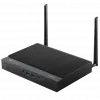
The RJ-50 connector is a registered jack standard often used for telephone system connections. It is similar in appearance to the more common RJ-45 connector, but with a different number of positions and contacts. Here are some key characteristics of the RJ-50 connector:
-
Physical Appearance: The RJ-50 connector looks similar to an RJ-45 connector, featuring a plastic body with eight contacts arranged in two rows.
-
Number of Contacts: Unlike the RJ-45 connector used for Ethernet networking (which has eight contacts), the RJ-50 has ten contacts arranged in two rows of five.
-
Usage: The RJ-50 connector is commonly used for telephone connections, particularly in environments where more than four conductors are needed. It is often employed for connecting telephone handsets to base units or for other communication equipment.
-
Wiring Configuration: The wiring configuration for the RJ-50 is similar to that of an RJ-45, but with additional contacts. Standard Ethernet cables with RJ-45 connectors may not be compatible with RJ-50 jacks due to the difference in the number of contacts.
-
Applications: While RJ-45 connectors are widely used for Ethernet networking, RJ-50 connectors are typically associated with telephone systems and some serial communication applications.
It's important to note that the RJ-50 is not as standardized or as widely used as some other RJ connectors, and its usage can vary depending on specific applications and equipment. If you encounter an RJ-50 connector, it's essential to understand the specific requirements and wiring configurations associated with the equipment in which it is used.
